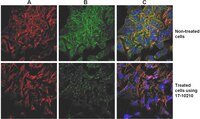ECM534 Sigma-Aldrichβ Integrin-mediated Cell Adhesion Array Kit, fluorimetric
The Beta Integrin-Mediated Cell Adhesion Array Kit can be used for assessing the presence or absence of specific integrins on the cell surface.
More>> The Beta Integrin-Mediated Cell Adhesion Array Kit can be used for assessing the presence or absence of specific integrins on the cell surface. Less<<Recommended Products
Overview
| Replacement Information |
|---|
Key Specifications Table
| Detection Methods |
|---|
| Fluorescent |
| References |
|---|
| Product Information | |
|---|---|
| Components |
|
| Detection method | Fluorescent |
| Quality Level | MQ100 |
| Physicochemical Information |
|---|
| Dimensions |
|---|
| Materials Information |
|---|
| Toxicological Information |
|---|
| Safety Information according to GHS |
|---|
| Safety Information |
|---|
| Packaging Information | |
|---|---|
| Material Size | 1 plate |
| Material Package | 96 wells |
| Transport Information |
|---|
| Supplemental Information |
|---|
| Specifications |
|---|
| Global Trade Item Number | |
|---|---|
| Catalog Number | GTIN |
| ECM534 | 04053252268540 |
Documentation
β Integrin-mediated Cell Adhesion Array Kit, fluorimetric SDS
| Title |
|---|
Technical Info
| Title |
|---|
| Integrin Profiling of Stem Cells and Differentiated Progeny |
| Screening Kits to Monitor Cell - Extracellular Matrix Interactions |








